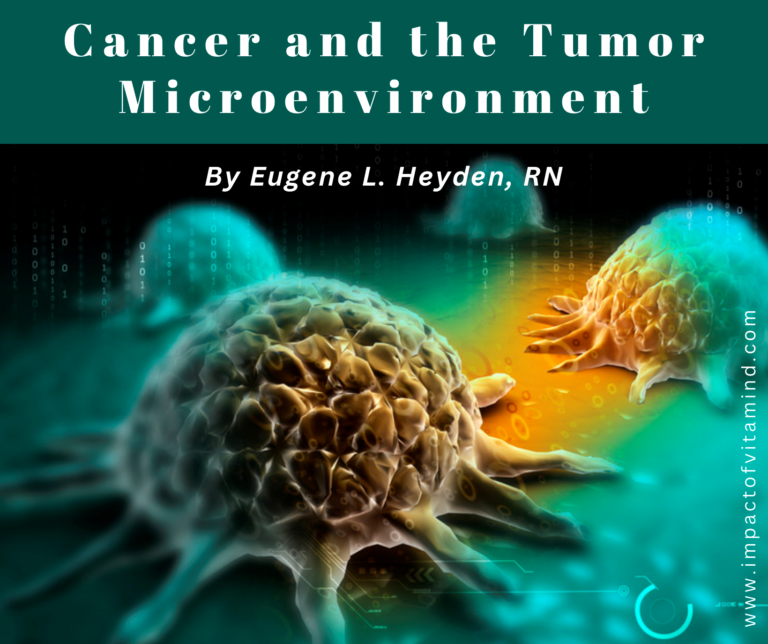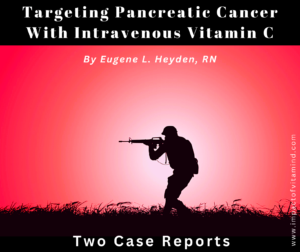Cancer and the Tumor Microenvironment

By Eugene L. Heyden, RN
“Although macrophages can target transformed [premalignant] cells, cancer cells evade this defense by reprogramming macrophages so that they support tumor progression.” ~ Geeraerts et al., 2017, emphasis added
It has been said that cancer is “a wound that will not heal.” (Dehne et al., 2017). But perhaps a better description of cancer would be “cells that have gone over to the dark side.” (The Author, 2023) Intriguingly, and in a disastrous sort of way, one of the cells that have turned from an “ally” into “enemy” is the immune cell we call the macrophage. This is the cell we will focus on in this story. By the way, this is a true story.
The macrophage is first a monocyte, a cell created and incubated within the bone marrow, destined to find its way into the bloodstream and begin its work. This “pre-macrophage” ordinarily circulates throughout the body, and in great numbers (looking for trouble), but in greater numbers if there is suspicion that a cancer or other evil is present somewhere in the body (Lewis et al., 2005; Geeraerts et al., 2017). Once the monocyte arrives on the scene of a cancer, it transforms into an activated macrophage (Lewis et al., 2005). And over time, the macrophage population in the tumor environment expands in numbers, so much so that macrophage numbers may actually exceeding the number of cancer cells in a given tumor (Zhou et al., 2022; Lewis et al., 2005). Amazing! But actually, not so great.
With respect to cancer, one of the jobs the macrophage is tasked with is to identify the cancer cell then eat it for lunch. It’s a pretty good job for an immune cell that loves to eat. So, it welcomes the opportunity to serve. But not content with just killing and eating, the macrophage plays a leadership role in an orchestrated crusade to defeat the enemy, an enemy that poses a clear and present danger. And like any good leader, it is great at delegating tasks to others.
According to the scheme of things, the macrophage has the ability to activate and direct the actions of other immune cells. One such immune cell is the natural killer (NK) cell (Lewis et al., 2005). Another such immune cell the T cell (Lewis et al., 2005). The NK cell is tasked with killing wayward cells when instructed to do so, while the T cell helps identify the cancer cell and aids in its destruction (Tan et al., 2021). All this should be happening, the cancer should never survive, should never increase in size, should never invade other tissues, should never spread to a galaxy far far away; but it can survive, multiply, invade, and metastasize to nearby or to distant locations. And the strange reason why: the cancer cell, therefore the tumor itself, takes matters into its own hands. The cancer has the skills, survival skills, that it takes to shut down the intentions of the immune cells that show up with the intent of killing. It does this by taking advantage of the low oxygen (hypoxic) tumor environment it finds itself in and indeed creates, a force field if you will (Lewis et al., 2005; Casazza et al., 2014). Not only does the macrophage fall under the spell of the hypoxic tumor environment, but the cancer cell also emits signals that reprogram the behavior of the macrophage and bring it fully under control of the dark side (Dehne et al., 2017; Geeraerts et al., 2017). The cancer can even entrap the macrophage within its territory, with no real hope of escape (Lewis et al., 2005). And the same is true of the NK cell, as it, too, becomes trapped within the confines of the hypoxic tumor environment, rendering it powerless (Casazza et al., 2014). Of course, all this spells trouble. So, as you can see, a lot is going on in the hypoxic tumor microenvironment, and not to your benefit.
So, what is going on here?
“Generally, macrophages grow into two main groups called classically activated macrophages (M1) and alternatively activated macrophages (M2). M2 and a small fraction of M1 cells, also known as TAMs [tumor-associated macrophages], not only lack the function of phagocytizing [eating to destroy] tumor cells but also help these tumor cells escape from being killed and help them spread to other tissues and organs.” (Zhou et al., 2020)
This spells disaster. A cell trained to kill the cancer cell, becomes the cancer cell’s best friend and shields it from harm. This is what makes cancer cell so hard to eliminate. The macrophage, an immune cell that should be solving the problem, is the problem! Within the tumor, the macrophage has become the “central driver” of an impaired immune response that favors the survival of the tumor (DeNardo et al., 2019). And someone on earth becomes very busy trying not to die. (I have someone in mind.) Most unfortunately, the cell that should be driving all “kill the cancer” efforts, the macrophage, has lost all interest in this and has betrayed our trust.
With respect to cancer, what the tumor-associated macrophage should be doing is this:
- Identifying, engulfing, and killing cancer cells (Lewis et al., 2005; Zheng et al., 2022)
- Releasing molecules that have “cytotoxic effects on tumor cells” (Pan et al., 2020)
- Presenting select body parts (antigens) of previously destroyed cancer cells to other immune cells so they can formulate the appropriate response (Lewis et al., 2005; Zheng et al., 2022)
- Assisting and stimulating NK cells and T cells in their personal efforts to kill the cancer cell (Lewis et al., 2005, Tan et al., 2021)
On the other hand, in the hypoxic tumor microenvironment, the tumor-associated macrophage is doing this:
- Promoting tumor survival and progression (Geeraerts et al., 2017)
- Producing growth factors that enable the cancer to develop a supportive vasculature, to proliferate, to invade nearby tissues, and to metastasize (Lewis et al., 2005)
- Producing factors that that allow the cancer to evade detection by the immune system (Lewis et al., 2005)
- Suppressing the numbers of T cells in the region and blocking their anti-tumor functions (Lewis et al., 2005; Dehne et al., 2017; DeNardo et al., 2019)
- Secreting factors that help tumors to resist chemotherapy (Jayasingam et al., 2020)
- Preventing the internal signaling pathways that would otherwise lead to the programed death of the cancer cell (Jayasingam et al., 2020)
So, as you can see, the macrophage is at the heart of tumor development and serves to protect the tumor, the cancer, from destruction. For now, the macrophage is your enemy. It has gone over the dark side.
I tell you this story because there is hope.
“Reprogramming or ‘repolarizing’ TAMs towards an anti-tumor phenotype could therefore prove a more efficacious—if potentially more toxic—approach to augmenting other forms of immunotherapy. (DeNardo et al., 2019)
There are ways to reprogram the macrophage, but that’s a story for another time. And in such a story, you might hear the words lactoferrin, curcumin, chloroquine, and intravenous vitamin C—all agents that promote the M1 macrophage phenotype and just may “reprogram” the M2 macrophage and turn it into a force for good.
Final thoughts
In view of the above, the following seems to be a wise course of action: When evaluating a particular therapy—a treatment, drug, or supplement—ask yourself the question “What does this do to the macrophage? Then do your homework. If a particular therapy promotes and sustains the M1 phenotype, it may be helpful. If, on the other hand, it promotes and sustains the M2 phenotype, it may not be so good. And remember, in everything you do, the entire universe is at stake.
I leave you with this:
“As macrophages have dual properties, eliminating or reducing the infiltration of macrophages may lead to infection, thus macrophage “reprogramming” should be the first choice for tumor immunotherapy.” (Zhou et al., 2022, emphasis added)
Related posts (Click image to open)
References
Casazza A, Di Conza G, Wenes M, Finisguerra V, Deschoemaeker S, Mazzone M. Tumor stroma: a complexity dictated by the hypoxic tumor microenvironment. Oncogene. 2014 Apr;33(14):1743-54. https://www.nature.com/articles/onc2013121
Dehne N, Mora J, Namgaladze D, Weigert A, Brüne B. Cancer cell and macrophage cross-talk in the tumor microenvironment. Current opinion in pharmacology. 2017 Aug 1;35:12-9. https://www.sciencedirect.com/science/article/abs/pii/S1471489216301503
DeNardo DG, Ruffell B. Macrophages as regulators of tumour immunity and immunotherapy. Nature Reviews Immunology. 2019 Jun;19(6):369-82. https://www.nature.com/articles/s41577-019-0127-6
Geeraerts X, Bolli E, Fendt SM, Van Ginderachter JA. Macrophage metabolism as therapeutic target for cancer, atherosclerosis, and obesity. Frontiers in immunology. 2017 Mar 15;8:289. https://www.frontiersin.org/articles/10.3389/fimmu.2017.00289/full
Jayasingam SD, Citartan M, Thang TH, Mat Zin AA, Ang KC, Ch’ng ES. Evaluating the polarization of tumor-associated macrophages into M1 and M2 phenotypes in human cancer tissue: technicalities and challenges in routine clinical practice. Frontiers in oncology. 2020 Jan 24;9:1512. https://www.frontiersin.org/articles/10.3389/fonc.2019.01512/full
Lewis C, Murdoch C. Macrophage responses to hypoxia: implications for tumor progression and anti-cancer therapies. The American journal of pathology. 2005 Sep 1;167(3):627-35. https://www.sciencedirect.com/science/article/pii/S000294401062038X
Pan Y, Yu Y, Wang X, Zhang T. Tumor-associated macrophages in tumor immunity. Frontiers in immunology. 2020 Dec 3;11:583084. https://www.frontiersin.org/articles/10.3389/fimmu.2020.583084/full
Tan Y, Wang M, Zhang Y, Ge S, Zhong F, Xia G, Sun C. Tumor-associated macrophages: a potential target for cancer therapy. Frontiers in Oncology. 2021 Jun 10;11:693517. https://www.frontiersin.org/articles/10.3389/fonc.2021.693517/full
Zheng Y, Han Y, Sun Q, Li Z. Harnessing anti‐tumor and tumor‐tropism functions of macrophages via nanotechnology for tumor immunotherapy. InExploration 2022 Jun (Vol. 2, No. 3, p. 20210166). https://onlinelibrary.wiley.com/doi/abs/10.1002/EXP.20210166
Zhou J, Tang Z, Gao S, Li C, Feng Y, Zhou X. Tumor-associated macrophages: recent insights and therapies. Frontiers in oncology. 2020 Feb 25;10:188. https://www.frontiersin.org/articles/10.3389/fonc.2020.00188/full
Zhou X, Wang X, Sun Q, Zhang W, Liu C, Ma W, Sun C. Natural compounds: A new perspective on targeting polarization and infiltration of tumor-associated macrophages in lung cancer. Biomedicine & Pharmacotherapy. 2022 Jul 1;151:113096. https://www.sciencedirect.com/science/article/pii/S0753332222004851
DISCLAIMER: This article is offered solely for informational purposes. The information contained therein and opinions expressed should be evaluated for accuracy and validity in the context of opposing data, new information, and the views and recommendations of a qualified health care professional, and not to be substituted for professional judgment and guidance or to provide a reason to neglect or delay appropriate medical care for self or for others. It is the reader and reader only who bears the responsibility for any actions that could be construed as being a response to the information presented. The statements and opinions expressed by the author have not been reviewed or approved by the FDA or by any other authoritative body, nor is the author endorsing any product or specific therapy mentioned. This article and the opinions contained therein are offered to the reader to broaden his or her understanding of the issues discussed and to help identify options that may be suitable for the individual to pursue, on behalf of self or others, under approval and direction of a qualified physician or medical team member. All questions of a medical nature which arise from reading this article should be directed at qualified health care professional. There are no guarantees that a suggested website and internal links are safe to visit or open or are currently available.
Copyright © 2023 Eugene L. Heyden, RN
All Rights Reserved


